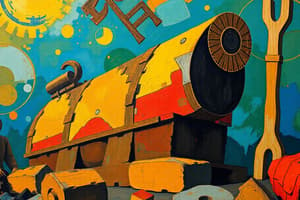Podcast
Questions and Answers
What are the four Vedas and their significance in the Vedic Period?
What are the four Vedas and their significance in the Vedic Period?
The four Vedas are Rigveda, Samaveda, Yajurveda, and Atharvaveda, and they provide essential knowledge about the Vedic Period and its cultures.
How did the political structure of the Vedic civilization change from the Early to the Later Vedic Period?
How did the political structure of the Vedic civilization change from the Early to the Later Vedic Period?
The Early Vedic Period had non-hereditary Rajas without capitals or armies, while the Later Vedic Period saw the establishment of hereditary kingship with multiple small and large kingdoms.
What were some of the key tools developed during the Iron Age, and how did they impact agriculture?
What were some of the key tools developed during the Iron Age, and how did they impact agriculture?
Key tools included the sickle, axe, and shovel, which improved farming efficiency and enabled large-scale cultivation.
How did the Iron Age contribute to the development of cities and trade?
How did the Iron Age contribute to the development of cities and trade?
What does the term 'Aryans' refer to in the context of the Rigveda?
What does the term 'Aryans' refer to in the context of the Rigveda?
What occupations were common among the people of the ancient Iranian civilization?
What occupations were common among the people of the ancient Iranian civilization?
What was the significance of Painted Grey Ware during the Iron Age?
What was the significance of Painted Grey Ware during the Iron Age?
In what ways did literature flourish during the Iron Age, and what were its impacts?
In what ways did literature flourish during the Iron Age, and what were its impacts?
What notable inventions did the Roman civilization contribute during its height?
What notable inventions did the Roman civilization contribute during its height?
Describe the religious practices of the Greek and Roman civilizations during the Iron Age.
Describe the religious practices of the Greek and Roman civilizations during the Iron Age.
Flashcards are hidden until you start studying
Study Notes
Iron Age Civilisation
- Iron Age began around 1200 BC, succeeding the Bronze Age.
- Discovery of iron led to stronger tools including sickles, shovels, spades, axes, saws, and nails.
- Advancements in agriculture due to improved tools allowed for large-scale cultivation.
- Increased urbanization with the rise of cities and towns that became trade and craft centers.
- Civilizations flourished around the Mediterranean Sea, fostering trade and exchange of ideas.
- Replacement of barter system with currency facilitated economic transactions.
Painted Grey Ware
- Characteristic ceramics of the Iron Age, fired grey and decorated with black designs.
- Common vessels included plates and bowls made from Painted Grey Ware.
- The Iron Age also marked significant achievements in literature, including poems, grammar, history, and self-expression through writing.
Development of Religions
- Greek civilization engaged in polytheism, worshiping deities like Zeus.
- Roman civilization honored gods such as Vesta, Venus, Jupiter, Mars, and Mercury.
- Iranian civilization followed Zoroastrianism, venerating gods like Vayu and Mittru.
Vedic Civilization
- The term "Veda" translates to "knowledge"; central to information from this historical period.
- Four main Vedas: Rigveda, Samaveda, Yajurveda, and Atharvaveda.
- Vedic Period is divided into Early Vedic (Rig Vedic) and Later Vedic (Epic Age) periods.
- Rigveda, composed around 3500 years ago, includes over 1000 hymns known as Sukta.
- Early Vedic Rajas lacked cities, palaces, armies, and taxes; kingship was not hereditary.
- Later Vedic saw the emergence of various kingdoms with hereditary leadership.
Civilizations Overview
- Greek Civilization: Agriculture, shipbuilding, and sculpture. Significant for calculating Earth's circumference and the Olympic Games.
- Roman Civilization: Agriculture, trade, and war. Known for innovations like concrete, advanced water systems, and Roman laws.
- Iranian Civilization: Engaged in trade, silk weaving, and various crafts. Developed Aramaic script and opulent palace decorations.
Studying That Suits You
Use AI to generate personalized quizzes and flashcards to suit your learning preferences.





